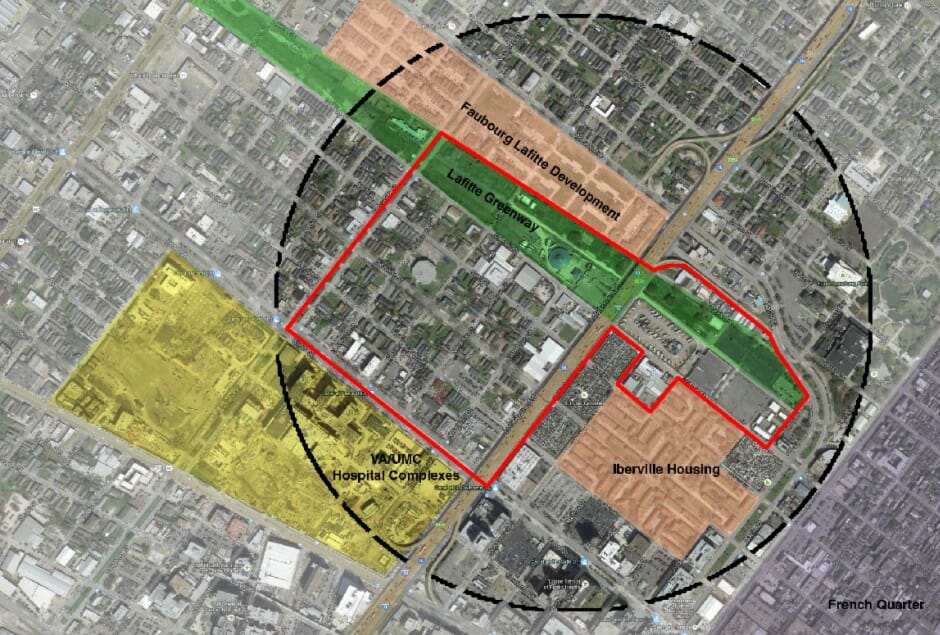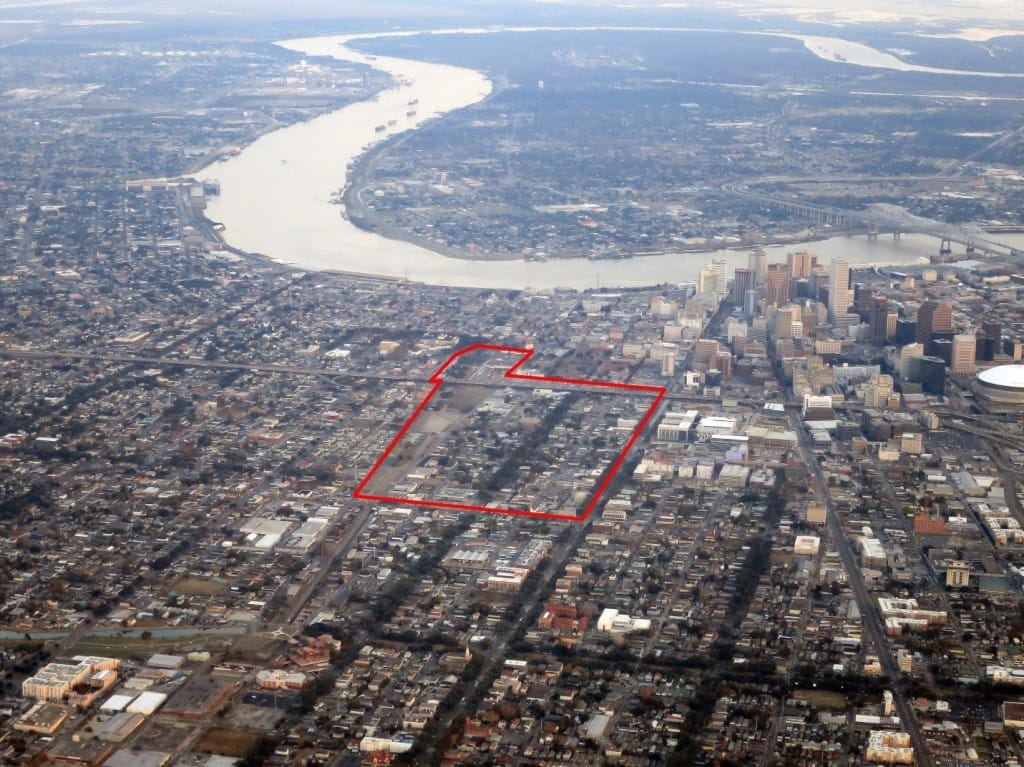Top Story
Downtown New Orleans Site Selected as Study Area for 2015 ULI Hines Competition
January 12, 2015
Student Teams Challenged To Design Sustainable Vision for Parts of Tulane/Gravier and Iberville Neighborhoods
For more information, contact Robert Krueger at 202-624-7051
WASHINGTON (January 12, 2015) – A downtown neighborhood in New Orleans has been chosen as the site for the thirteenth annual Urban Land Institute (ULI) Hines Competition, the Institute announced today. The ideas competition provides graduate-level student teams the opportunity to devise a comprehensive design and development program for parts of the Tulane/Gravier and Iberville downtown neighborhoods. The team with the winning proposal, selected in April, will receive $50,000.
The 2015 competition, which kicked off today, is designed to simulate an actual urban planning and development scenario, with certain details changed for the purposes of the competition. It is based on a hypothetical situation in which community stakeholders, including residents, land owners, local businesses, and others in the area bound by the upcoming Lafitte Greenway, the eastern edge of the new medical district, and crossed by the elevated I-10 highway, have come together to create the North Claiborne Neighborhood Improvement Association (NCNIA) – a fictional entity created for the purpose of the competition. NCNIA is concerned that the competition’s study area is subject to influence from future surrounding developments and has asked for proposals to sustain a growing and thriving community.
Specifically, NCNIA is seeking a masterplan proposal that not only transforms the area into a thriving urban neighborhood, but also highlights its locational advantages, including its proximity to the French Quarter, adjacency to the medical district, and interaction with the Lafitte Greenway. The proposal should show an understanding of all factors at play, both market and non-market, in building sustainable and thriving communities as highlighted in ULI’s Ten Principles for Building Healthy Places. Student team proposals must be comprehensive and take into account many site factors, including the Lafitte Greenway, the new Faubourg Lafitte housing development, the edge of St. Louis Street, the University Medical Center (UMC) and Veterans Administration (VA) hospital complexes, and the relation to both North Claiborne and the I-10 highway.
The study area is part of the neighborhoods most commonly known as Tulane/Gravier and Iberville. This historically rich area is composed of a mixture of residential, industrial and commercial zoning that includes manufacturing plants and other small industrial complexes, many defunct, others still operational. Due to its unique location, the neighborhood faces the challenge of retaining the existing communities, while accommodating the new density that new workforce needs will demand of the area.
While based on a hypothetical situation, the 2015 Hines competition does reflect many real-life concerns of New Orleans. The competition addresses the city’s continued effort to develop sustainable neighborhoods that represent New Orleans’s uniqueness with the promise of economic innovation and inclusion, as well as access to cultural, employment, transportation, and housing resources. As part of these efforts, the city recently completed the Livable Claiborne Communities (LCC) study. This study, encompassing seven diverse neighborhoods and a portion of the Central Business District, links community revitalization analysis and recommendations for the Claiborne Corridor with transportation and redevelopment scenarios. The LCC study provides a holistic approach to community revitalization combined with a set of alternative scenarios for transportation and development opportunities over the next 20 to 30 years in an area that includes this study area.
The Hines competition is part of an ongoing ULI effort to raise interest among young people in creating better communities, improving development patterns, and increasing awareness of the need for interdisciplinary solutions to development and design challenges. The competition is strategically structured to encourage cooperation and teamwork—necessary talents in the planning, design and development of sustainable communities—among future land use professionals and allied professions, such as architecture, landscape architecture, urban planning, historic preservation, engineering, real estate development, finance, psychology and law. It is open to graduate students who are pursuing real estate-related studies at universities in the United States and Canada, including programs in real estate development, urban planning, urban design, architecture and landscape architecture.
The competition has been funded through a $3 million endowment from Gerald D. Hines, chairman of the global Hines real estate organization and a recipient of the ULI J.C. Nichols Prize for Visionaries in Urban Development. A legend in the land use industry, he is widely known as a leader who pioneered the use of high-quality planning and architecture as a marketable feature of development in office, residential and mixed-use projects.
In February, the jury will select four student teams as finalists. These teams are then requested to expand their proposal and present it to the jury in New Orleans. A $50,000 prize will be awarded to the winning team, with $5,000 of the total going to the school. Each of the remaining three finalist teams will receive $10,000. This year, applications were submitted from 140 teams representing 70 universities in the United States and Canada, with 700 students participating in total. Since the first competition was held in 2003, over 6,000 students on over 1,000 teams have participated, representing schools in the U.S. and Canada.
The teams will be expected to submit proposals that illustrate innovative approaches to five general elements: 1) planning context and analysis, 2) master land use plan, 3) urban design, 4) site specific illustrations of new development, and 5) development schedule and finances. Participants have received project briefing materials, including a comprehensive problem statement; background information on the site; market information; relevant existing design proposals; site maps and photos; and other details, along with a list of materials required for team presentations. The competition is designed as an exercise; there is no intention that the students’ plans will be implemented as part of any revitalization of the site.
The teams must complete their project proposals and submit them to ULI headquarters by January 26, 2015. A jury will review all proposals in compliance with the deadline and select four finalist teams and several honorable mentions. The finalist and honorable mentions will be announced to the public in late February. In March, the final phase of the competition, the student finalist teams will have the opportunity to expand their original schemes and respond in more detail. During this time, a member of each team will be brought to New Orleans to tour the site and revise their presentations. In April, finalist team members will present their schemes to the competition jury members during a public forum in New Orleans. The event will culminate with the announcement of the winning team.
Reflecting the multidisciplinary nature of the competition, ULI will select 12 jurors from diverse backgrounds in real estate development. Jurors are often a strategic mix of land use experts, including developers, brokers, architects, urban designers, landscape architects, urban planners, and policy officials, among others.
For more information on the ULI Gerald D. Hines Student Urban Design Competition, visit: http://americas.uli.orghines.
###
About the Urban Land Institute
The Urban Land Institute (uli.org) is a nonprofit education and research institute supported by its members. Its mission is to provide leadership in the responsible use of land and in creating and sustaining thriving communities worldwide. Established in 1936, the Institute has more than 33,000 members representing all aspects of land use and development disciplines.

